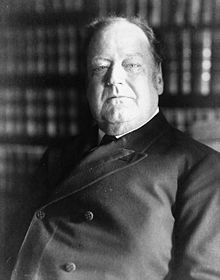
Back إدوارد دوغلاس وايت Arabic ادوارد دوجلاس وايت ARZ ادوارد دی. وایت AZB Edward Douglass White Czech Edward Douglass White junior German Edward Douglass White Spanish ادوارد دی. وایت Persian Edward Douglass White French אדוארד דאגלס וייט HE Edward D. White Hungarian
Edward Douglass White | |
|---|---|
 White in 1905 | |
| 9th Chief Justice of the United States | |
| In office December 19, 1910 – May 19, 1921[1] | |
| Nominated by | William Howard Taft |
| Preceded by | Melville Fuller |
| Succeeded by | William Howard Taft |
| Associate Justice of the Supreme Court of the United States | |
| In office March 12, 1894 – December 18, 1910[1] | |
| Nominated by | Grover Cleveland |
| Preceded by | Samuel Blatchford |
| Succeeded by | Willis Van Devanter |
| United States Senator from Louisiana | |
| In office March 4, 1891 – March 12, 1894 | |
| Preceded by | James Eustis |
| Succeeded by | Newton Blanchard |
| Justice of the Louisiana Supreme Court | |
| In office January 1879 – April 1880 | |
| Nominated by | Francis T. Nicholls |
| Preceded by | William B. Giles Egan |
| Personal details | |
| Born | Edward Douglass White Jr. November 3, 1845 Thibodaux, Louisiana, U.S. |
| Died | May 19, 1921 (aged 75) Washington, D.C., U.S. |
| Resting place | Oak Hill Cemetery |
| Political party | Democratic |
| Spouse |
Leita Montgomery Kent
(m. 1894) |
| Education | Mount St. Mary's University (AB) Georgetown University Tulane University (LLB) |
| Signature | |
Edward Douglass White Jr. (November 3, 1845[2][3] – May 19, 1921) was an American politician and jurist. White, a native of Louisiana, was a U.S. Supreme Court justice for 27 years, first as an associate justice from 1894 to 1910, then as the ninth chief justice from 1910 until his death in 1921. White is known for siding with the Supreme Court majority in Plessy v. Ferguson, which upheld the legality of state segregation.
Born in Lafourche Parish, Louisiana, White practiced law in New Orleans after graduating from the University of Louisiana, now Tulane University. He also attended the College of the Immaculate Conception, present-day Jesuit High School in New Orleans, class of 1865. His father, Edward Douglass White Sr., was the 10th Governor of Louisiana and a Whig US Representative. White fought for the Confederacy during the Civil War and was captured in 1865. After the war, White won election to the Louisiana State Senate and served on the Louisiana Supreme Court. As a member of the Democratic Party, White represented Louisiana in the United States Senate from 1891 to 1894.
In 1894, President Grover Cleveland appointed White as an associate Justice of the U.S. Supreme Court. In 1910, President William Howard Taft elevated him to the position of chief justice. The appointment surprised many contemporaries, as Taft was a member of the Republican Party. White served as chief justice until his death in 1921, when he was succeeded by Taft.
White notably sided with the Supreme Court majority in Plessy v. Ferguson, upholding the legality of state segregation to provide "separate but equal" public facilities in the United States. White would go on to write notable opinions in landmark cases such as Talton v. Mayes, Lone Wolf v. Hitchcock, Guinn v. United States, and the Selective Draft Law Cases.
- ^ a b "Justices 1789 to Present". www.supremecourt.gov. Washington, D.C.: Supreme Court of the United States. Archived from the original on April 15, 2010. Retrieved January 19, 2019.
- ^ Birth-Baptismal Record of Edouard Douglas White (Record Number: 1844-606) child of E.D. White and Sidney Ringgold, baptized December 30, 1844, in Thibodaux, LA by Rev. Chs. M. Menard. Date of birth November 3, 1844. Diocese of Houma-Thibodaux, Office of Archives, Historical Research Center, 205 Audubon Avenue, Thibodaux, LA 70301. Abstracted on April 8, 2008
- ^ Reeves, William D. (1999). Dr. James White, Governor E.D. White and Chief Justice Edward Douglass white of Louisiana. Thibodaux, Louisiana: The Friends of the Edward Douglass White Historic Site. p. 96. ISBN 1-887366-33-4.